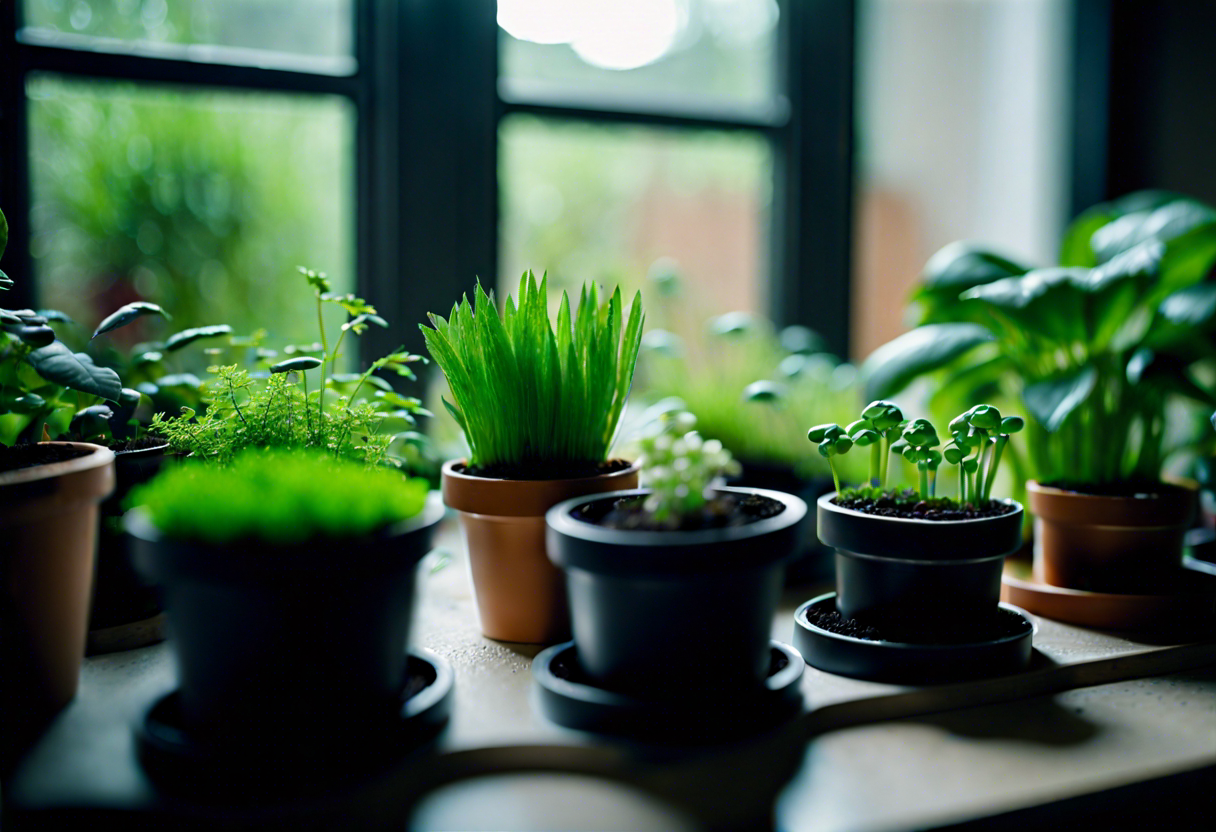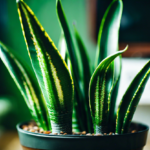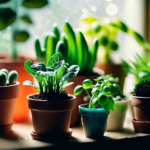The Benefits of Starting an Indoor Garden for Beginners
Starting an indoor garden can be a rewarding and fulfilling experience for beginners. Not only does it bring nature into your home, but it also offers a range of benefits that promote physical and mental well-being. Whether you have limited outdoor space, live in an apartment, or simply want to enjoy gardening year-round, an indoor garden is a perfect solution. Let’s explore the many benefits of starting an indoor garden for beginners.
One of the primary benefits of indoor gardening is the ability to grow plants all year round. Unlike outdoor gardens, which are limited by seasonal changes, indoor gardens provide a controlled environment conducive to plant growth throughout the year. This means you can enjoy fresh herbs, vegetables, and flowers regardless of the weather outside.
Indoor gardens also allow beginners to have more control over the growing conditions. You can adjust factors such as temperature, humidity, lighting, and watering to meet the specific needs of different plants. This level of control helps beginners gain confidence and develop their gardening skills at their own pace.
In addition to providing a year-round growing season and control over growing conditions, indoor gardens offer numerous health benefits. Plants naturally purify the air by removing harmful toxins and releasing oxygen. This can improve indoor air quality and reduce the risk of respiratory problems. Indoor gardening is particularly beneficial for individuals with allergies or asthma.
Gardening has been proven to have therapeutic effects on mental health as well. The act of tending to plants can promote relaxation, reduce stress, and increase mindfulness. It provides a sense of purpose and accomplishment, especially when you see your plants thrive and flourish under your care. Indoor gardening can be a form of self-care and a way to connect with nature in a busy, urban lifestyle.
Another advantage of starting an indoor garden is the aesthetic appeal it brings to your home. Plants add color, texture, and life to indoor spaces, creating a calming and visually pleasing environment. They can be arranged in various ways, from hanging baskets to shelves and windowsills, allowing you to personalize your indoor garden to suit your style and taste.
Starting an indoor garden is an excellent choice for beginners, offering a wide range of benefits. It provides a year-round growing season, control over growing conditions, improved air quality, and mental well-being. Additionally, indoor gardens enhance the aesthetic appeal of your home, adding beauty and tranquility to your living spaces. So why wait? Start your indoor garden today and embark on a rewarding journey of nurturing and growth.
The Essential Tools and Supplies for Indoor Gardening
Starting an indoor garden can be a rewarding and fulfilling experience for beginners. Not only does it provide a way to bring nature indoors, but it also offers a host of benefits, such as cleaner air, stress relief, and the joy of watching plants grow and thrive. To ensure a successful indoor gardening journey, it’s important to have the right tools and supplies at your disposal. Here are some essential items to consider:
-
Pots and Containers: Choose pots or containers that are appropriate for the size of the plants you’re planning to grow. Ensure they have drainage holes to prevent waterlogging, which can lead to root rot. Ceramic, plastic, or terracotta pots are popular choices.
-
Soil: Use a well-draining potting mix specifically formulated for indoor plants. Avoid using garden soil as it may contain pests, weed seeds, or excessive amounts of clay.
-
Watering Can or Misting Bottle: A watering can with a narrow spout is convenient for providing water directly to the plant’s base. For plants that require higher humidity levels, misting bottles can be used to achieve the desired moisture.
-
Gardening Gloves: Protect your hands from dirt, thorns, or any potential allergens by using gardening gloves. Opt for gloves that offer a good balance between comfort and durability.
-
Pruning Shears: Trimming and pruning are essential for maintaining the health and shape of your plants. Invest in a pair of high-quality pruning shears to ensure clean cuts and minimize damage to your plants.
-
Plant Fertilizer: Indoor plants often require additional nutrients to thrive. Choose a suitable plant fertilizer based on the type of plants you have and follow the instructions for application.
-
Grow Lights: If your indoor gardening space lacks sufficient natural light, consider investing in grow lights. These artificial lights mimic the sun’s spectrum and ensure your plants receive the necessary light for photosynthesis.
-
Plant Labels: Keep track of your plants by labeling them. Use waterproof plant labels or small decorative markers to identify each plant and any important care instructions.
-
Moisture Meter: A moisture meter enables you to monitor the moisture level of the soil accurately. This tool prevents overwatering or underwatering, which can be detrimental to your plants’ health.
-
Cleaning Supplies: Regularly clean your indoor gardening tools, pots, and surfaces to prevent the spread of pests and diseases. Maintain cleanliness by having a spray bottle with a diluted bleach solution and clean cloth or paper towels.
These are just a few of the essential tools and supplies you’ll need to start your indoor gardening journey. Remember to do research on the specific needs of your chosen plants to provide them with optimal care. With the right tools and a little bit of love and attention, you’ll be well on your way to creating a thriving indoor garden. Happy gardening!
Choosing the Right Plants for Your Indoor Garden
Indoor gardening is a wonderful way to bring nature into your home and enjoy the benefits of cultivating living plants, even if you don’t have access to an outdoor garden space. However, as a beginner, it’s important to choose the right plants for your indoor garden to ensure a successful and rewarding experience. Here are some factors to consider when selecting plants for your indoor garden.
-
Light requirements: One of the most crucial factors to consider when choosing plants for your indoor garden is their light requirements. Different plants have varying needs for light intensity and duration. Some plants, such as succulents and cacti, thrive in bright, direct sunlight, while others, like ferns and certain herbs, prefer indirect or even low-light conditions. Assess the amount of natural light available in your home and select plants accordingly.
-
Space availability: The size and space available in your indoor garden will determine the types of plants you can grow. If you have limited space, consider plants that are compact, such as dwarf varieties or those that can be grown in hanging baskets. Alternatively, if you have a larger area to work with, you can explore larger plants or even create a small indoor garden with multiple levels and shelves.
-
Maintenance requirements: As a beginner, it’s advisable to start with plants that are relatively low-maintenance and forgiving. Some plants require frequent watering, while others are more tolerant of occasional neglect. Consider your availability and commitment level to caring for your indoor garden. For example, if you travel frequently, you may want to choose plants that can withstand longer periods without water.
-
Air quality: Indoor plants not only add beauty to your space but also help improve air quality by filtering toxins and releasing oxygen. If improving indoor air quality is a priority for you, consider plants that are known for their air-purifying properties, such as snake plants, pothos, or peace lilies. These plants can help remove harmful pollutants and create a healthier environment in your home.
-
Personal preferences: Ultimately, your preferences and tastes should guide your plant selection. Do you prefer flowering plants or those with vibrant foliage? Are you interested in growing herbs, vegetables, or ornamental plants? Consider your personal preferences and choose plants that will bring you joy and align with your aesthetic preferences.
When starting an indoor garden as a beginner, it’s advisable to start small and gradually expand as you gain more experience and confidence. Choose a variety of plants that suit your space and personal preferences, and don’t be afraid to experiment. Remember to pay attention to each plant’s specific needs regarding light, water, and temperature to ensure their thriving growth. With proper care and attention, your indoor garden will become a haven of greenery and a source of joy in your home.
Setting Up Your Indoor Garden Space
When starting an indoor garden, one of the first steps is to set up a dedicated space for your plants. This will ensure they have the right conditions to thrive. Here are some important considerations to keep in mind when creating your indoor garden space:
Location
Choose a location in your home that receives sufficient natural light. Most indoor plants require at least six to eight hours of sunlight per day. South-facing windows are ideal, as they tend to provide the brightest light. If you don’t have access to adequate natural light, you can supplement it with artificial grow lights.
Temperature and Humidity
Ensure that the temperature in your indoor garden space remains within the optimal range for your plants. Most indoor plants prefer temperatures between 65-75°F (18-24°C). Avoid placing your plants near drafty windows or heating/cooling vents, as these can cause temperature fluctuations that may harm your plants.
Additionally, it’s important to provide adequate humidity for certain plants. Consider placing a humidifier nearby or misting your plants regularly to increase humidity levels.
Air Circulation
Good air circulation is essential for the health of your indoor plants. Avoid overcrowding your plants, as this can restrict airflow and increase the risk of pests and diseases. Ensure that there is enough space between plants for proper ventilation.
You can also use a small fan to improve air circulation in your indoor garden space. This will help prevent stagnant air and promote healthy growth.
Containers and Potting Soil
Choose suitable containers for your indoor plants. Look for pots with drainage holes to prevent waterlogging and ensure proper drainage. Avoid decorative containers without drainage holes, as they can cause water to accumulate and lead to root rot.
Use well-draining potting soil specifically formulated for indoor plants. This type of soil promotes healthy root growth and provides proper nutrition for your plants.
Organizing and Labeling
Organize your indoor garden space by grouping plants with similar care requirements together. This will make it easier to provide the appropriate care for each plant. Additionally, labeling your plants can help you keep track of their specific needs and make maintenance tasks more efficient.
By following these steps, you can create a well-planned and organized indoor garden space that will provide the optimal conditions for your plants to thrive. Remember to regularly monitor your plants’ health and make any necessary adjustments to ensure their well-being. Happy gardening!
Tips for Maintaining and Caring for Your Indoor Garden
Starting an indoor garden can be a rewarding and fulfilling experience, but it also requires proper maintenance and care. To ensure the health and success of your plants, there are several key tips to keep in mind. By following these guidelines, even beginner gardeners can enjoy the beauty and benefits of an indoor garden for years to come.
1. Watering: One of the most crucial aspects of indoor gardening is getting the watering right. Each plant has specific water requirements, so it’s essential to understand the needs of your chosen plants. Overwatering can lead to root rot, while underwatering can cause dehydration and wilting. Pay attention to the soil’s moisture levels and adjust your watering routine accordingly.
2. Lighting: Adequate lighting is crucial for the growth and development of indoor plants. While natural light is ideal, not all areas of your home may have access to sufficient sunlight. In such cases, you can use artificial lights, such as fluorescent or LED grow lights, to provide the necessary light spectrum for plant growth. Ensure that the lights are positioned at the correct distance from the plants to avoid burning or stunting their growth.
3. Temperature and Humidity: Maintaining the right temperature and humidity levels is essential for the well-being of your indoor garden. Most indoor plants prefer temperatures between 60°F and 75°F (15°C to 24°C) during the day and slightly cooler temperatures at night. Additionally, certain plants thrive in higher humidity levels, so consider using a humidifier or placing a tray of water near your plants to increase humidity if needed.
4. Fertilization: Indoor plants rely on you for their nutritional needs, as they don’t have access to natural sources of nutrients like outdoor plants. Fertilizing your indoor garden regularly will provide the necessary minerals and vitamins for healthy growth. Choose a balanced, water-soluble fertilizer and follow the recommended dosage and frequency instructions for each specific plant.
5. Pest Control: Just like outdoor gardens, indoor plants can also fall victim to pests. Common indoor garden pests include aphids, spider mites, and fungus gnats. Regularly inspect your plants for signs of infestation, such as yellowing leaves, sticky residue, or small insects. If you notice any pests, treat them immediately using organic or chemical-free pest control methods to protect your plants.
6. Pruning and Grooming: Regular pruning and grooming will keep your indoor plants looking their best and encourage healthy growth. Remove any dead leaves or flowers, trim overgrown branches, and shape the plants as desired. This will improve the overall appearance of your indoor garden and prevent overcrowding and competition for resources among the plants.
7. Monitoring and Observation: Take the time to observe and monitor your indoor garden regularly. Pay attention to the overall health and appearance of your plants, including any signs of disease, nutrient deficiencies, or environmental stress. Promptly address any issues that arise to prevent further damage and ensure the longevity of your indoor garden.
By following these tips for maintaining and caring for your indoor garden, you can create a thriving and beautiful indoor oasis. Remember, each plant is unique, so take the time to understand the specific needs of your chosen plants and adjust your care routine accordingly. With patience, dedication, and a little bit of green thumb, your indoor garden will flourish and bring you joy for years to come.
Conclusion
Starting an indoor garden for beginners can be a rewarding and fulfilling experience. Not only does it offer numerous benefits, but it also allows you to bring nature indoors and create a beautiful and relaxing space in your home. By understanding the benefits and having the right tools and supplies, choosing the right plants, setting up your indoor garden space, and following tips for maintenance and care, you can successfully begin your journey as an indoor gardener.
One of the key benefits of starting an indoor garden is the positive impact it can have on your overall well-being. Indoor plants help improve air quality by filtering toxins and releasing oxygen, creating a healthier living environment. They also contribute to stress reduction and can boost your mood, leading to a more peaceful and calming space. Furthermore, indoor gardening provides a sense of accomplishment and the opportunity to nurture and care for living things.
To get started, it is important to have the essential tools and supplies for indoor gardening. These include containers or pots with proper drainage, potting soil, watering cans or misters, a pair of gloves, and a set of gardening tools such as pruners and trowels. Having the right tools will make the gardening process easier and more efficient.
Choosing the right plants for your indoor garden is crucial. Consider factors such as lighting conditions, space availability, and your level of experience. Some popular beginner-friendly plants include snake plants, pothos, spider plants, and succulents. These plants are known for their resilience and ability to thrive in a variety of indoor environments.
Setting up your indoor garden space requires careful consideration of lighting and space requirements. Most indoor plants need bright, indirect light, so placing them near a window or using artificial grow lights can help meet their lighting needs. Additionally, organizing your plants in a visually appealing and functional manner will enhance the overall aesthetic of your indoor garden.
Maintaining and caring for your indoor garden is essential to ensure the health and longevity of your plants. Regular watering, proper fertilization, and monitoring for pests are some crucial tasks. It is important to establish a watering schedule based on the specific needs of each plant and avoid overwatering, as it can lead to root rot. Additionally, regularly inspecting the leaves for signs of pests or diseases and promptly addressing any issues will help keep your plants healthy.
Starting an indoor garden for beginners involves understanding the benefits, acquiring the essential tools and supplies, carefully choosing the right plants, setting up the garden space properly, and following tips for maintenance and care. By doing so, you can create a thriving indoor garden that brings joy, beauty, and a sense of tranquility to your home. So roll up your sleeves, dig in the dirt, and enjoy the journey of nurturing your very own indoor oasis.


